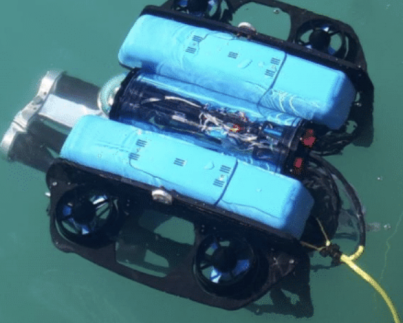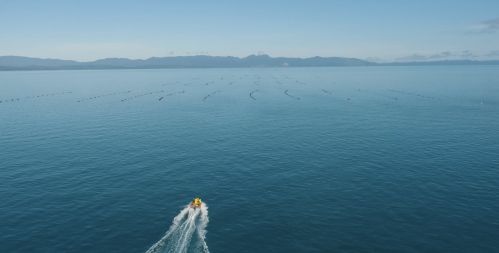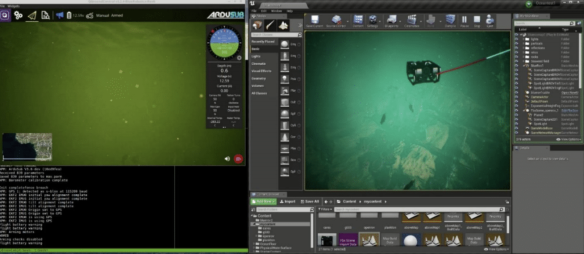Ending with impact: Unleashing underwater Robots on Aotearoa’s export market
A team of SfTI researchers are developing a market-disrupting robot that free-dives and can navigate independently underwater whilst seeking out and identifying species.
 This work builds on SfTI’s $5 million Precision Farming Technologies for Aquaculture Spearhead research project which used a ‘tethered’ robot to track mussel ropes. Acquiring mussel size and health data is expensive and labour-intensive. Even with manually operated tethered underwater vehicles that are sometimes used in aquaculture operations. This new project is focused on taking this concept and improving it dramatically with autonomous navigation and novel Artificial Intelligence (AI) for recognising species. Effectively the robot will be ‘untethered’ and able to learn its environment itself. This will not only offer benefits for the aquaculture industry but has the potential to be game-changing for biosecurity.
This work builds on SfTI’s $5 million Precision Farming Technologies for Aquaculture Spearhead research project which used a ‘tethered’ robot to track mussel ropes. Acquiring mussel size and health data is expensive and labour-intensive. Even with manually operated tethered underwater vehicles that are sometimes used in aquaculture operations. This new project is focused on taking this concept and improving it dramatically with autonomous navigation and novel Artificial Intelligence (AI) for recognising species. Effectively the robot will be ‘untethered’ and able to learn its environment itself. This will not only offer benefits for the aquaculture industry but has the potential to be game-changing for biosecurity.
Image: A tethered remotely operated vehicle (ROV).
This project is part of a new suite of SfTI funding to enable our most promising Spearhead research projects to ‘end with impact’. All National Science Challenges, including SfTI, will draw to a close in June 2024 and it’s vital that every drop of practical impact from our research is delivered. In a 2022 funding round, our Spearhead projects were invited to put forward ideas that have germinated during their work of the past few years, and that with more time and investment could reap impactful rewards.
Project lead, Richard Green from Canterbury University, says that this project presents a huge potential cost saving for marine farmers and could do the same in several industries.
“This robot not only has huge benefits for the local marine farmers looking to grow Aotearoa’s economy by billions but could become a very attractive export in itself for marine industries globally.
“This robot not only has huge benefits for the local marine farmers looking to grow Aotearoa’s economy by billions but could become a very attractive export in itself for marine industries globally.
This technology has a huge existing international market of marine farmers who need to automate the expensive and labour-intensive job of checking underwater gear. Plus the foundational technology that the robot will be built on can rapidly respond to new markets or opportunities.
“Its potential impact could also be in its ability to more effectively protect our marine environments from invasive species, by providing a more cost effective way to monitor the hulls of boats and other underwater structures that present biosecurity risk.”
Long-term relationships with Kaitiaki
Working directly with iwi and industry is an important feature of SfTI’s ‘ending with impact’ research projects. This project is working alongside Aotearoa’s marine farmers building on relationships developed as part of the original Spearhead. Currently working with Ngāi Tahu, Wakatū, Moana NZ and Te Rūnanga o Ngāi Tahu owned mussel farms at Port Levy, the team are able to have access to industry trends and field trial locations.
Richard says that these long-term relationships are essential to ensure that the technology aligns with the industry needs and kaitiakitanga principles.
“As well as our relationships with iwi owned marine farmers we work with the Cawthron’s Māori Business Development Unit to integrate Mātauranga Māori into the research.
This project has the potential to contribute to the Māori economy and as kaitiaki and owners of marine farms with strong intergenerational interests in commercial and recreational fishing, Māori are integral project partners and beneficiaries of this work.”
The project also makes use of connections made during the SfTI Spearhead with New Zealand companies at the cutting edge of data science and robotics, including Boxfish, Bay Dynamics, Blue Robotics, Nelson AI and ocean data science specialist Oceanum.
Richard says these relationships take the work into the real world and out of the lab.
“I look forward to seeing research outputs actually being used and useful to others, rather than just collecting dust on the shelf.”
Aotearoa, the perfect training ground for the first-in-its-kind robot

Aotearoa’s complex and wild ocean environments provide the right challenges to develop a robot that needs to be able to look after itself underwater while doing a job that has to date been the domain of trained divers.
Image: A Golden Bay mussel farm
Richard says the challenge and opportunity is to automate manual labour tasks in such a hostile environment.
“With Rapid 3D colour scanning and recognition of underwater surfaces, objects and organisms to new levels of accuracy, this robot will be able to use novel Artificial Intelligence (AI) approaches to automatically scan’ for crop health, condition, biofouling, or conditions of structures.”

Image: Simulator which enables rapid prototyping of novel navigation.
“No one yet has the capability to accurately autonomously scan complex underwater surfaces with 0.1mm 3D colour resolution. It is this accuracy that enables AI to recognise objects or species and also autonomously perform manual labour tasks in a changing environment."
A young future-focussed team
SfTI's ‘ending with impact’ research projects have also placed emphasis on creating opportunities for emerging researchers. This project benefits from a team which is majority emerging researchers.
Tim Rensen is in the third year of his PhD in computer science and is the technical lead in hardware and electronics for the project.
Tim says that being part of a young team helps them to be agile in product design and bring fresh ideas and perspectives into an industry which has been dominated by million-dollar robots operated from large ships and by highly trained staff. He is also passionate about the potential environmental impact of this project.
“This project has the potential to have a massive impact on how humanity interacts with the marine environment, especially in coastal waters where communities grow and harvest food. We are learning to treat the ocean as a precious resource to be nurtured with its complex and delicate ecology rather than a bottomless cookie jar to be raided.”
“This project has the potential to have a massive impact on how humanity interacts with the marine environment, especially in coastal waters where communities grow and harvest food. We are learning to treat the ocean as a precious resource to be nurtured with its complex and delicate ecology rather than a bottomless cookie jar to be raided.”
Richard says it is exciting to have such a young team and such an ambitious and yet achievable goal.
“I hope we’ll see that all over the world, folk are using affordable reliable NZ tech to scan mooring lines, mussel farms, salmon nets and wharf pylons.”
The project is funded for $750,000 to March 2024. Find out more about our ‘ending with impact’ projects